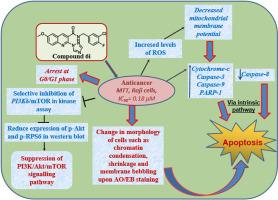Novel anticancer inhibitors targeting the PI3K/Akt/mTOR signaling route and apoptosis inducers: A study on the apoptosis mechanism via the intrinsic mitochondrial-mediated pathway
IF 5.4
2区 医学
Q1 BIOCHEMISTRY & MOLECULAR BIOLOGY
引用次数: 0
Abstract
The PI3K/Akt/mTOR pathway is a key target for cancer due to its essential role in cell proliferation. This study developed quinoline compounds as a potent PI3Kδ/mTOR inhibitor and apoptosis inducer. The investigation found that 6i had the highest cytotoxicity against Raji and HeLa cells, with IC50s values of 0.18μM and 0.39μM, respectively. Further, 6i demonstrated substantial selectivity against dual targets PI3Kδ (IC50 = 0.034μM) and mTOR (IC50 = 0.047 μM). The kinase assay discovered that 6i had a greater selectivity for PI3Kδ/mTOR compared to PI3Ks (α, β, and γ). Molecular investigation revealed that 6i significantly reduced phosphorylated p-PI3K, p-Akt and p-RPS6 levels in Western blot, confirming PI3K/Akt/mTOR as the pathway of action. In addition, compound 6i stopped the cell cycle at the G0/G1 phase and raised total apoptosis by 16.26%. These findings were substantiated by morphological alterations in the AO/EB staining. Furthermore, 6i-treated cells increased intracellular ROS levels and reduced mitochondrial membrane polarization in a dose-dependent manner, indicating that apoptosis was mediated by a mitochondrial route. In addition, higher levels of Bax, Bax/Bcl-2 ratio, and cytochrome c also corroborated the fact that apoptosis was mediated via mitochondrial pathway. Also, treatment of compound increased fraction of caspase-3, caspase-9, and PARP-1 (excluding caspase-8), indicating that apoptosis was mediated via the intrinsic route. Besides, in silico studies had validated the anticancer effects of inhibiting PI3Kδ/mTOR. Moreover, 6i demonstrated a promising safety profile in hERG assay. Taken together, our finding suggest that 6i may be a potential candidate for further in vivo investigation.

靶向PI3K/Akt/mTOR信号通路的新型抗癌抑制剂和凋亡诱导剂:线粒体介导的细胞凋亡机制研究
由于PI3K/Akt/mTOR通路在细胞增殖中发挥重要作用,因此是癌症的关键靶点。本研究发现喹啉类化合物是一种有效的PI3Kδ/mTOR抑制剂和细胞凋亡诱导剂。研究发现,6i对Raji和HeLa细胞的细胞毒性最高,ic50值分别为0.18 μM和0.39 μM。此外,6i对PI3Kδ (IC50 = 0.034 μM)和mTOR (IC50 = 0.047μM)具有很强的选择性。激酶分析发现,与pi3k (α、β和γ)相比,6i对PI3Kδ/mTOR具有更高的选择性。Western blot结果显示,6i显著降低磷酸化的p-PI3K、p-Akt和p-RPS6水平,证实了PI3K/Akt/mTOR是其作用途径。此外,化合物6i使细胞周期停止在G0/G1期,使总凋亡数增加16.26%。AO/EB染色的形态学改变证实了这些发现。此外,6i处理的细胞以剂量依赖的方式增加了细胞内ROS水平,减少了线粒体膜极化,表明凋亡是通过线粒体途径介导的。此外,Bax、Bax/Bcl-2比值和细胞色素c的升高也证实了细胞凋亡是通过线粒体途径介导的。此外,化合物处理增加了caspase-3、caspase-9和PARP-1的含量(不包括caspase-8),表明凋亡是通过内在途径介导的。此外,在计算机上的研究证实了抑制PI3Kδ/mTOR的抗癌作用。此外,6i在hERG试验中显示出良好的安全性。综上所述,我们的发现表明6i可能是进一步体内研究的潜在候选者。
本文章由计算机程序翻译,如有差异,请以英文原文为准。
求助全文
约1分钟内获得全文
求助全文
来源期刊
CiteScore
7.70
自引率
3.90%
发文量
410
审稿时长
36 days
期刊介绍:
Chemico-Biological Interactions publishes research reports and review articles that examine the molecular, cellular, and/or biochemical basis of toxicologically relevant outcomes. Special emphasis is placed on toxicological mechanisms associated with interactions between chemicals and biological systems. Outcomes may include all traditional endpoints caused by synthetic or naturally occurring chemicals, both in vivo and in vitro. Endpoints of interest include, but are not limited to carcinogenesis, mutagenesis, respiratory toxicology, neurotoxicology, reproductive and developmental toxicology, and immunotoxicology.

 求助内容:
求助内容: 应助结果提醒方式:
应助结果提醒方式:


